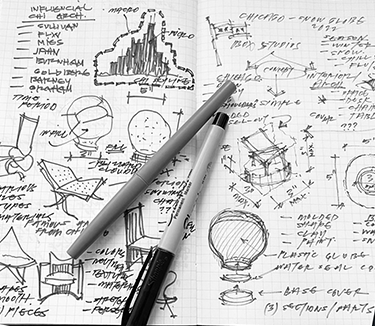
A sketch a day keeps the world closer.
A sketch a day strengthens your imagination.
A sketch a day sharpens your skills.
A sketch a day becomes a habit like waiting for the sun to rise.
A sketch a day records moments in time.
A sketch a day keeps your eyes looking.
A sketch a day keeps your mind drawing.
A sketch a day…. are you ready?
Activity 1 – History of Sketching
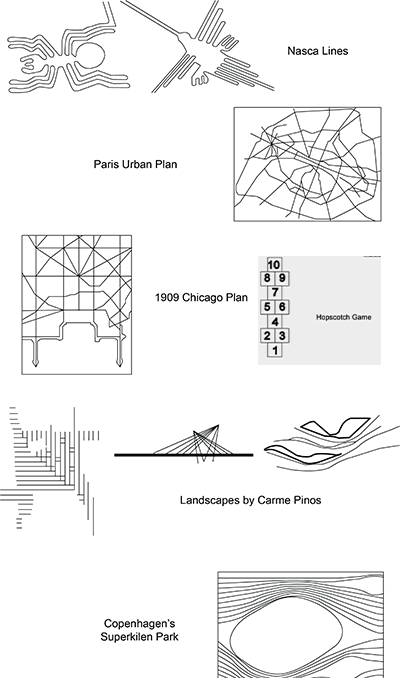
Sketches start with lines. Humans encounter outlines or edges of shapes and forms when they are looking. Humans as a species are curious and look down, out, up, and around to learn about the world. Since the beginning, humans have made marks to communicate directions, quantities, geometries, alphabets, boundaries, stories, histories, and so much more. The earliest known drawings on slate and wooden panels have been found and are on display in museums around the world. From Egyptian times onward, sketchbooks, originally on cloth, then on parchment, began to record ideas about the movement of the sun, people, animals, plants, and the geometries of construction, etc. Recording thoughts, events, stories, memories, and ideas became an active practice by monks and certain civilizations. Early books were hand-written and eventually included artist drawings to record views, scenes, landscapes, and more. Today, more than ever, people love to sketch in sketchbooks. Even with the advent of photography, the ability to sketch, record, iterate, identify, and record notations is still an enduring asset to looking, learning, and living!
Activity 2 – Prehistoric Sketches
Artists throughout history drew even before they painted, sculpted, or created. Prehistoric Cave Drawings at several locations record animals that were hunted. Watch the Cave de Lascaux Video. Caves in Spain recorded animals, and scenes between 35,000 and 11,000 years ago.
Activity 3 – Window Sketching
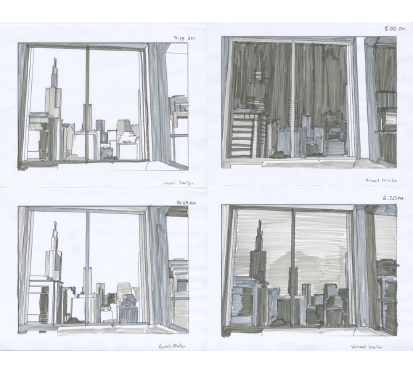
A window frame serves as a canvas for creating a sketch. Looking out your window, you can see where you are if you just take the time. Sketching helps record and document views. Artists like Albrecht Dürer used sketchbooks to record their ideas and observations. Try drawing the same view out of a window at different times of the day. Make a morning, noon, dinner, and evening view. When the sun is up, you can clearly see the edges of the buildings and their windows. After sunset, the sky gets darker and buildings become shadowed, and we lose the ability to see details clearly. In the night, buildings and houses may have lights on. Though the buildings are dark, the windows may light up different geometries.
What do you notice?
Activity 4 – Geometry in sketching

During the Renaissance, artists like Andrea Palladio began using sketchbooks for various purposes, including scientific speculations, anatomical drawings, and notes for paintings.
Andrea Palladio shared the geometry of his own work while providing geometric layouts from the classical periods of temples, rooms, doors, etc. Leonardo da Vinci’s sketchbooks are famous for containing detailed anatomical studies, scientific speculations, and sketches for inventions, simple machines, and more.
Looking at the geometry of a scene is a good way to start drawing objects, buildings, and views. Look for simple shapes first- circles, squares, triangles. When sketching, scale is important. What is the largest thing you see? What are the smallest things?
Activity 5 – Sketching views
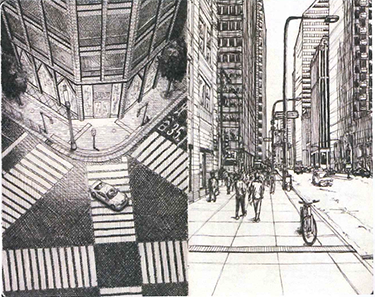
When drawing a view, think about the foreground, midground, and background. Backgrounds are in the distance. When drawing nature, the background establishes the horizon line in the distance. You can draw a one-point, 2-point, or 3-point perspective depending on your point of view. The midground is between you and the background. The foreground is the thing or things that you can see with the most detail.
Activity 6 – Sketching Analytiques
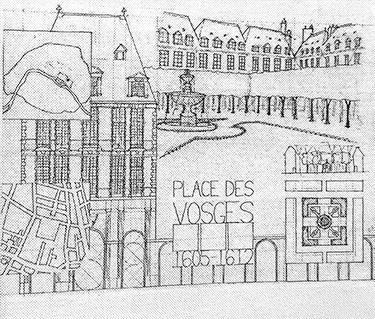
Analytical studies are studies of a place, including plans, elevations, and details. When analyzing a space, take time to walk around it and notice its geometry, space, and details. Analytiques share a location map, plan of the space, different views including entries, destinations, and facades in 1, 2, or 3 point perspectives.
Start sketching!
Activity 7 – Sketching Nature
Sketching is a wonderful way to record what you see. Looking outside, you can sketch the land Topography
and landscape as settings in Nature. Remember, Nature evolved plants and animals for billions of years before people arrived.
You can capture the beauty of scenes in the countryside. Draw fields, rolling hills, trees, and more. You can capture the waves at the seaside.
Check out NEXT.cc’s Nature Journaling and start exploring the world outdoors!
Activity 8 – Sketching buildings
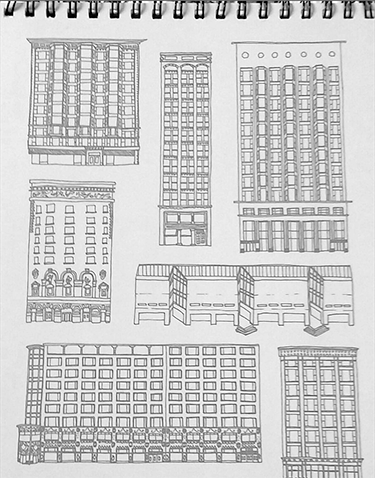
Sketching buildings and skylines is an excellent way to document where you live. Recording the types of buildings and houses right where you live opens many opportunities to look at diverse facades, materials, architectural periods, and cultures in a town, village, or city. Sketching them also connects you to diverse materials, geometries, and houses. Each one is different.
Look around you at houses and housing in your neighborhood. Check out NEXT.cc’s Vernacular Housing to learn about housing types all over the world. Look at NEXT.cc’s Housing Styles, and Facade Elements including Windows and doors . Each combination suggests different characters and offers different experiences of entry, and connection with the outdoors. Where do people live in the United States?
Look at Civic buildings like schools and universities. Have educational campuses changed over time?
Do you know any religious structures in your neighborhood? Sketch key houses and buildings in your community.
Become a neighborhood artist!
Activity 9 – Sketchbooks as A Creative Tool
Over the centuries, sketchbooks have become an essential tool for artists, providing a space to jot down ideas, experiment with different concepts, and capture fleeting moments. Artists use graphite, crayons, pens, and watercolor to record what they are experiencing. Artist Harrison Cady(1877-1970, sketched scenes from summer visits to Rockport, Maine. Scientists are also known to keep journals and sketchbooks as part of their investigation processes. Review key strategies for keeping a Laboratory Notebook to better understand the discipline of documenting data on a changing collection.
Sketchbooks offer a unique glimpse into the creative process of artists, architects, scientists, ecologists, and more, revealing their thoughts, ideas, and artistic explorations. Today, sketchbooks come in various forms, from traditional bound notebooks to digital sketchbooks, continuing to be a valuable tool for artists, scientists, environmentalists, and more.
Review
Explore
- A Brief History of Sketchbooks
- ARCHITECT SKETCHBOOKS
- Architizer Sketchbook Entries (slow load)
- ARTIST SKETCHBOOKS
- Autodesk Sketchbook
- Brief History of Sketchbooks
- Diebenkorn Sketchbooks STANDFORD
- Drawing Matter
- Liz+Borromini Sketchbook Trips
- Sketches and Drawings of Louis Kahn
- Victoria & Albert Architect's Sketchbooks
Relate
- 2D Geometry
- 3D Geometry
- 7 Natural Wonders
- Aquifers
- Architectural Lettering
- Architectural Modeling
- Architecture
- Composition
- Conceptual Sketching
- Design Process
- Design Research
- Design Thinking
- Detail
- Diagramming
- Drawing Types
- Font
- Habitats
- Imagination
- Isometric
- Lines
- Nature
- Nature Journaling
- Nature Patterns
- Perspective
- Proportion
- Shading
- Shape
- Shelter
- Sketching
- Space
- Sunlight
- symmetry
- Timelines
- Visual Note Taking


















































